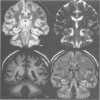Abstract
OBJECTIVE: To assess the diagnostic value of the fast FLAIR sequence in patients with epilepsy. METHODS: One hundred and twenty eight patients with epilepsy and 10 control subjects were scanned with the fast FLAIR sequence with 5 mm slices, a coronal gradient echo (GRE) T1 weighted sequence with 1.5 mm slices and spin echo (SE) or fast spin echo (FSE) proton density and T2 weighted sequences with 5 mm slices. All images were compared by an unblinded neuroradiologist and neurologist. Fast FLAIR images of patients with hippocampal sclerosis (HS) and normal control subjects were also evaluated by two blinded independent raters. RESULTS: Fast FLAIR provided a high conspicuity of neocortical damage, hamartomas, dysembryoplastic neuroepithelial tumours, and clear cut hippocampal sclerosis. However, the same information could be obtained from the coronal T1 and T2 weighted images. In three patients fast FLAIR showed a clearly abnormal signal when SE T2 weighted images had not been definitely abnormal. Heterotopia was less conspicuous on fast FLAIR than GRE T1 weighted images. The two blinded raters detected all but one of the patients with clear cut hippocampal sclerosis on fast FLAIR images but missed all borderline cases of hippocampal atrophy and there were two false positives. Clear cut hippocampal sclerosis was more conspicuous on fast FLAIR images than on SE T2 weighted images in most patients, but additional patients were not identified. CONCLUSION: Fast FLAIR has the advantage of identifying neocortical lesions and definite hippocampal sclerosis with a short scanning time and may also demonstrate lesions when other sequences are normal in a limited number of cases. The technique was not useful, however, for identifying mild hippocampal sclerosis or heterotopia.
Full text
PDF




Images in this article
Selected References
These references are in PubMed. This may not be the complete list of references from this article.
- Bergin P. S., Fish D. R., Shorvon S. D., Oatridge A., deSouza N. M., Bydder G. M. Magnetic resonance imaging in partial epilepsy: additional abnormalities shown with the fluid attenuated inversion recovery (FLAIR) pulse sequence. J Neurol Neurosurg Psychiatry. 1995 Apr;58(4):439–443. doi: 10.1136/jnnp.58.4.439. [DOI] [PMC free article] [PubMed] [Google Scholar]
- Cook M. J., Fish D. R., Shorvon S. D., Straughan K., Stevens J. M. Hippocampal volumetric and morphometric studies in frontal and temporal lobe epilepsy. Brain. 1992 Aug;115(Pt 4):1001–1015. doi: 10.1093/brain/115.4.1001. [DOI] [PubMed] [Google Scholar]
- Duncan J. S., Sagar H. J. Seizure characteristics, pathology, and outcome after temporal lobectomy. Neurology. 1987 Mar;37(3):405–409. doi: 10.1212/wnl.37.3.405. [DOI] [PubMed] [Google Scholar]
- Free S. L., Bergin P. S., Fish D. R., Cook M. J., Shorvon S. D., Stevens J. M. Methods for normalization of hippocampal volumes measured with MR. AJNR Am J Neuroradiol. 1995 Apr;16(4):637–643. [PMC free article] [PubMed] [Google Scholar]
- Grünewald R. A., Jackson G. D., Connelly A., Duncan J. S. MR detection of hippocampal disease in epilepsy: factors influencing T2 relaxation time. AJNR Am J Neuroradiol. 1994 Jun;15(6):1149–1156. [PMC free article] [PubMed] [Google Scholar]
- Jackson G. D., Connelly A., Duncan J. S., Grünewald R. A., Gadian D. G. Detection of hippocampal pathology in intractable partial epilepsy: increased sensitivity with quantitative magnetic resonance T2 relaxometry. Neurology. 1993 Sep;43(9):1793–1799. doi: 10.1212/wnl.43.9.1793. [DOI] [PubMed] [Google Scholar]
- Li L. M., Fish D. R., Sisodiya S. M., Shorvon S. D., Alsanjari N., Stevens J. M. High resolution magnetic resonance imaging in adults with partial or secondary generalised epilepsy attending a tertiary referral unit. J Neurol Neurosurg Psychiatry. 1995 Oct;59(4):384–387. doi: 10.1136/jnnp.59.4.384. [DOI] [PMC free article] [PubMed] [Google Scholar]
- Raymond A. A., Fish D. R., Sisodiya S. M., Alsanjari N., Stevens J. M., Shorvon S. D. Abnormalities of gyration, heterotopias, tuberous sclerosis, focal cortical dysplasia, microdysgenesis, dysembryoplastic neuroepithelial tumour and dysgenesis of the archicortex in epilepsy. Clinical, EEG and neuroimaging features in 100 adult patients. Brain. 1995 Jun;118(Pt 3):629–660. doi: 10.1093/brain/118.3.629. [DOI] [PubMed] [Google Scholar]
- Raymond A. A., Fish D. R., Stevens J. M., Cook M. J., Sisodiya S. M., Shorvon S. D. Association of hippocampal sclerosis with cortical dysgenesis in patients with epilepsy. Neurology. 1994 Oct;44(10):1841–1845. doi: 10.1212/wnl.44.10.1841. [DOI] [PubMed] [Google Scholar]
- Rydberg J. N., Hammond C. A., Grimm R. C., Erickson B. J., Jack C. R., Jr, Huston J., 3rd, Riederer S. J. Initial clinical experience in MR imaging of the brain with a fast fluid-attenuated inversion-recovery pulse sequence. Radiology. 1994 Oct;193(1):173–180. doi: 10.1148/radiology.193.1.8090888. [DOI] [PubMed] [Google Scholar]
- Rydberg J. N., Riederer S. J., Rydberg C. H., Jack C. R. Contrast optimization of fluid-attenuated inversion recovery (FLAIR) imaging. Magn Reson Med. 1995 Dec;34(6):868–877. doi: 10.1002/mrm.1910340612. [DOI] [PubMed] [Google Scholar]
- Takanashi J., Sugita K., Fujii K., Niimi H. MR evaluation of tuberous sclerosis: increased sensitivity with fluid-attenuated inversion recovery and relation to severity of seizures and mental retardation. AJNR Am J Neuroradiol. 1995 Oct;16(9):1923–1928. [PMC free article] [PubMed] [Google Scholar]
- Van Paesschen W., Sisodiya S., Connelly A., Duncan J. S., Free S. L., Raymond A. A., Grünewald R. A., Revesz T., Shorvon S. D., Fish D. R. Quantitative hippocampal MRI and intractable temporal lobe epilepsy. Neurology. 1995 Dec;45(12):2233–2240. doi: 10.1212/wnl.45.12.2233. [DOI] [PubMed] [Google Scholar]





